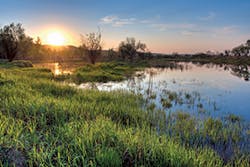US 36 Habitat Mitigation Project
Several wetland drainages, including a protected and critical willow habitat in the riparian zone of South Boulder Creek, are home to two federally protected species: the tiny Preble’s meadow jumping mouse and the beautiful but elusive Ute ladies’ tresses orchid, says Patrick Hickey, project manager and wetland and wildlife specialist with the Colorado Department of Transportation (CDOT). This type of habitat is generally threatened by development throughout Boulder and the Front Range of Colorado.
In 2004, a project to widen US Highway 36, which connects Boulder and Denver, threatened one of these wetlands. CDOT began consultations with the US Fish and Wildlife Service (USFWS) to minimize impacts and mitigate for the unavoidable ones.
CDOT, the Federal Highway Administration (FHA), USFWS, and the city of Boulder collaborated on the project, which took place on a parcel known as the Granite Property, a degraded 24-acre parcel of land just about a mile downstream of the protected wetland.
The Granite Property had suffered from extensive grazing and dumping and had an abundance of noxious weeds. Weeds are designated as noxious when they are injurious to natural habitats, ecosystems, humans, livestock, or agricultural and horticultural crops.
“The project was a good marriage of interests,” says Hickey. “The city wanted to protect the site from being developed. We met our environmental obligations by purchasing and restoring the parcel for mitigation, which will be managed as a nature preserve by the city.”
The project took place in the spring of 2014. The new habitat includes a considerably larger area than was originally affected by the highway widening, because the USFWS requires a larger amount of land to mitigate for the land that is lost. The FHA provided most of the funding.
CDOT created, restored, or enhanced 15.9 acres of wetlands and restored 8.4 acres of upland buffer habitat, for a total of 24.3 acres.
The main goal of the project was to recreate a matrix of habitat types on the Granite Property to suit the two threatened species. This included willow habitat, a relatively dense combination of grasses, forbs (wildflowers), and shrubs. The secondary goal was to transplant some of the orchids, along with large segments of the wetland sod associated with them, says Hickey.
There was no requirement to relocate the Preble’s meadow jumping mouse, which uses several of the drainages across some 3 acres within the highway project limits, including one that was directly adjacent to the constructed wetland. The year before the project began, the threatened area was mowed so the mouse would hibernate elsewhere during the winter.
“We hoped if we created a better habitat on the Granite site, then the adjacent mouse population would be able to expand its local range. The assumption was, ‘If you build it, they will come,’” he says. “We intend to monitor the site to determine if that is true.”
Jacobs Engineering, based in Pasadena, CA, designed the wetland and CDOT provided support. Both Jacobs and CDOT provided construction oversight. Rocky Mountain Excavation of Castle Rock, CO, was the prime contractor and did all the major earthwork.
Generally, the water table in these wetland areas ranges from zero to 24 inches below the surface during the growing season. Part of the Granite Property was already wetland. Rocky Mountain excavated another half of the land to create a larger one.
“The lower surface elevation was necessary to connect the wetland habitat to the supporting water table,” explains Hickey.
On the driest land, Rocky Mountain excavated some 6 inches, primarily to remove the weed-infested soil. Crews excavated other areas to a depth of 3 feet to allow more diverse wetland vegetation to grow. No groundwater was exposed.
Western States Reclamation, which has offices in Frederick and Loma, CO, and in Kayenta, AZ, handled all the vegetative and erosion control components of the project except for the mowing. Crews used heavy equipment to drive pilot holes into the cobbly gravel soil for the coyote willow (Salix exigua) stakes and planted more than 9,700 stakes in specific areas of some 6.4 acres of the wetland.
They also planted 6,000 riparian shrubs, including chokecherry (Prunus virginiana), golden current (Ribes aureum), Wood’s rose (Rosa woodsii), and Western snowberry (Symporicarpos occidentalis) in more than 13.7 acres. They overseeded with native grasses such as blue grama (Chondosum gracilis), side oats (Bouteloua curitipendula), and sand dropseed (Sporobolus cryptandrus). In addition, they put in native pollinator attractors such as prairie coneflower (Ratibida columnifera), sidebells penstemon (Penstemon secundiflorus), and white sagebrush (Artemisia ludoviciana).
In the protected wetland, the orchids were growing in an area of about a tenth of an acre. Transplanting them posed an interesting challenge.
“The orchids don’t come up every year,” says Hickey. “We surveyed the site for several years to understand where they were occurring.”
Western States Reclamation dug up five orchid plants by hand and excavated large sections of the soil associated with them. This ensured that their root systems would be undamaged. It also ensured that seeds, mycorrhizae, bacteria, and other elements necessary to the orchids’ health and reproduction would be transferred to the constructed wetland.
Within the constructed wetland, Rocky Mountain excavated an existing 40-foot by 800-foot section of a swale to approximately 18–24 inches deep. Western States Reclamation crews placed the orchid sod in the swale, which raised the soil level up to that of the surrounding land.
“We overseeded the wetland areas to increase species diversity,” says Hickey. “The local native grasses and forbs weren’t really present anymore.”
The same upland wetland species were used throughout, including Canada wildrye (Elymus Canadensis), western wheatgrass (Pascopyrum smithii), alkali sacaton (Sporobolus airoides), Dudley’s rush (Juncus dudleyi), purple verbena (Verbena hastate), large leaf avens (Guem macrophyllum), and golden banner (Thermopsis montana).
The city of Boulder’s Open Space and Mountain Parks Program will maintain the site, he says. “The city is very active in open-space preservation. This parcel will be closed to the public and maintained as a nature preserve.”
Western States Reclamation is maintaining the wetland, mainly watering, weeding, performing noxious weed control, and other vegetative maintenance, with the assistance of LT Environmental in Arvada, CO, which is responsible for the weed monitoring and reporting.
“We’ve been pleasantly surprised by the results of the project,” says Hickey. “We had a very wet year with some big flood cycles, which is helpful for the plant communities we’re trying to establish.”
Approximately four months after construction, the willow habitat had expanded. Approximately 90% of the planted willows were doing well. The native herbaceous understory species also had expanded. Some 95% of the planted shrubs survived, and the native seed was germinating well.
“I give a lot of credit to Western States Reclamation,” says Hickey. “I think their execution of the project was very good, which is reflected in the early seeding and planting success. That’s a function of their maintenance effort and favorable climatic conditions. They really exceeded our expectations.”


